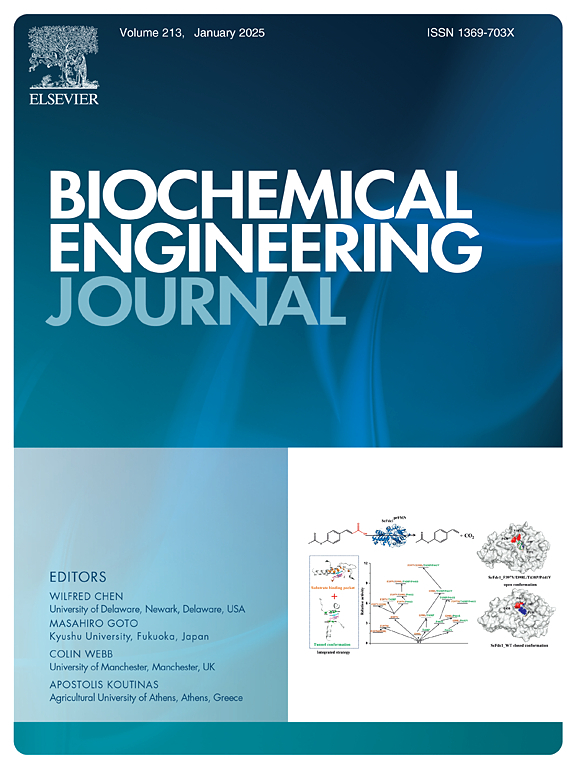增强贝氏梭菌 Y10 利用葡萄糖和木糖生产丙酮-丁醇-乙醇的策略及其生理机制探索
IF 3.7
3区 生物学
Q2 BIOTECHNOLOGY & APPLIED MICROBIOLOGY
引用次数: 0
摘要
为了提高丁醇的产量及其在总溶剂中的比例,研究了补充外源氨基酸对丙酮-丁醇-乙醇(ABE)发酵的影响。结果表明,在 18 小时内添加 5.0 mg/L 的苯丙氨酸时,丁醇和总溶剂的产量最高,分别为 14.18 ± 0.24 g/L 和 16.29 ± 0.31 g/L。此外,为了探索丁醇在最佳条件下高效合成的生理原因,研究了丁醇合成途径中关键酶活性的变化和细胞内微环境的变化。研究结果表明,苯丙氨酸的添加可提高乙酸激酶和丁酸激酶的粗酶活性,加强 NADH 的合成,消耗更多的 ATP,从而促进贝氏梭菌 Y10 的生长。这项研究表明,添加微量氨基酸是提高生物丁醇产量的一种简单而有效的方法,从而为提高其他类似发酵的性能提供了一种新策略。本文章由计算机程序翻译,如有差异,请以英文原文为准。
Strategies for enhanced acetone-butanol-ethanol production by Clostridium beijerinckii Y10 from glucose and xylose and exploration of its physiological mechanisms
To enhance the production of butanol and its ratio to the total solvent, the impacts of exogenous amino acids supplementation on acetone-butanol-ethanol (ABE) fermentation were studied. With this effort, the highest butanol and total solvent production of 14.18 ± 0.24 g/L and 16.29 ± 0.31 g/L were achieved when 5.0 mg/L of phenylalanine was added at 18 h. Additionally, to explore the physiological reasons for the efficient synthesis of butanol under the optimal condition, the changes of key enzyme activities in the butanol synthesis pathway and the intracellular microenvironment were investigated. The findings show that phenylalanine addition could enhance crude enzyme activities of acetate kinase and butyrate kinase activities, strengthen NADH synthesis and expend more ATP to promote the growth of Clostridium beijerinckii Y10. This study suggests that the method of a tiny amount of amino acid addition was a simple and efficient approach to enhance bio-butanol production, thus providing a new strategy to improve the performance of other similar fermentation.
求助全文
通过发布文献求助,成功后即可免费获取论文全文。
去求助
来源期刊

Biochemical Engineering Journal
工程技术-工程:化工
CiteScore
7.10
自引率
5.10%
发文量
380
审稿时长
34 days
期刊介绍:
The Biochemical Engineering Journal aims to promote progress in the crucial chemical engineering aspects of the development of biological processes associated with everything from raw materials preparation to product recovery relevant to industries as diverse as medical/healthcare, industrial biotechnology, and environmental biotechnology.
The Journal welcomes full length original research papers, short communications, and review papers* in the following research fields:
Biocatalysis (enzyme or microbial) and biotransformations, including immobilized biocatalyst preparation and kinetics
Biosensors and Biodevices including biofabrication and novel fuel cell development
Bioseparations including scale-up and protein refolding/renaturation
Environmental Bioengineering including bioconversion, bioremediation, and microbial fuel cells
Bioreactor Systems including characterization, optimization and scale-up
Bioresources and Biorefinery Engineering including biomass conversion, biofuels, bioenergy, and optimization
Industrial Biotechnology including specialty chemicals, platform chemicals and neutraceuticals
Biomaterials and Tissue Engineering including bioartificial organs, cell encapsulation, and controlled release
Cell Culture Engineering (plant, animal or insect cells) including viral vectors, monoclonal antibodies, recombinant proteins, vaccines, and secondary metabolites
Cell Therapies and Stem Cells including pluripotent, mesenchymal and hematopoietic stem cells; immunotherapies; tissue-specific differentiation; and cryopreservation
Metabolic Engineering, Systems and Synthetic Biology including OMICS, bioinformatics, in silico biology, and metabolic flux analysis
Protein Engineering including enzyme engineering and directed evolution.
 求助内容:
求助内容: 应助结果提醒方式:
应助结果提醒方式:


